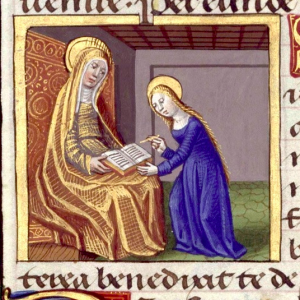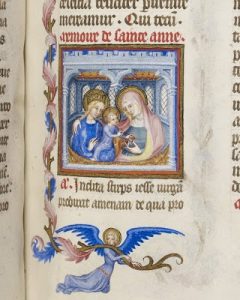[Header Image: BL Harley 2846, f. 40v]
From the early thirteenth century onwards, the pilgrims who flocked to Notre-Dame de Chartres in north-central France were keen to venerate one of the cathedral’s most famous relics: the head of Saint Anne, mother of the Virgin Mary.
![Sculpture of Anne holding the infant Mary; north porch of Chartres Cathedral. []Source](https://yvonneseale.org/wp-content/uploads/2016/07/576px-Cathedrale_nd_chartres_nord040-225x300.jpg)
The relic arrived in France in the aftermath of the Fourth Crusade. Louis, count of Blois and a grandson of Louis VII, was alleged to have discovered the head in Constantinople and sent it back to his homeland shortly before his death in the Battle of Adrianople in 1205. His widow, Catherine, countess of Clermont, presented the skull and an associated cloak to the cathedral at Chartres on Louis’ behalf. According to the cathedral’s necrology, which contains an account of the donation, “the mother’s head was received with great joy in the daughter’s church.”
Mother and Daughter at Chartres
Chartres had been a focus of Marian pilgrimage since the Carolingian period, when the Emperor Charlemagne was supposed to have presented the church with the Sancta Camisia, a tunic or veil believed to have once belonged to Mary. This relic drew the faithful for generations. In the late twelfth century, the poet Guillaume the Breton wrote of the cathedral:
Countless the signs and favours of grace by which the Blessed Virgin
Shows that the Mother of Christ has a special love for this one church,
Granting a minor place, as it were, to all other churches,
Deeming it right to be frequently called the Lady of Chartres.
This is also the place where everyone worships the tunic
Worn on the day of the birth of the Lamb, by the Virgin as garment.
The cathedral therefore seemed an appropriate resting place for the relics of Mary’s mother, and in honour of Anne, the cathedral was decorated with sculpture and stained glass showing her holding the infant Mary.
The Origins of Saint Anne
In the later Middle Ages, Saint Anne was regarded as the matriarch of an extended Holy Kindred and her feast day was celebrated with great solemnity on July 26. Stories about Anne and her children were told, retold, and popularised in works like Jacobus de Voragine’s Legenda aurea and Vincent of Beauvais’ Speculum historiale. This was all despite the fact that neither Anne nor any of her family (with the exception of Mary and Jesus) appear in the canonical Gospels, nor is there any historical evidence for her existence.

In fact, Anne first appears in texts like the mid-second-century Protoevangelium of James, an apocryphal gospel that described Mary’s birth and childhood. The life story crafted for Anne by the Protoevangelium‘s author echoes that of the Old Testament figure Hannah, mother of the prophet Samuel. Both women were devout and childless; the faith of both was rewarded with the birth of remarkable children.
Anne’s rise in popularity over several centuries—she appeared first in theological writings, then increasingly in popular accounts; first in the Greek East and then in the Latin West—depended on a number of factors. Anne’s presence helped to resolve some of the theological questions that surrounded just how a human woman could give birth to God—if Mary was conceived without original sin, what must her parents have been like? As a pious woman and doting mother and grandmother, Anne helped to humanise some of the more mysterious aspects of the Incarnation.
As the number of stories about Anne expanded, so too did the size of her family. By the later Middle Ages, people believed that Anne had married three times and had a daughter called Mary by each marriage. The three Marys then had children of their own: Jesus Christ and several of his disciples. This tangled family tree helped to resolve contradictory or confusing genealogical references in scripture. But likely much more immediately appealing to medieval people was that Anne—a mother and grandmother, a widow who remarried—provided lay women with a model of piety which was compatible with sexual activity within marriage. Unlike most people previously heralded as saints, Anne hadn’t abjured sex and parenthood in favour of saintly celibacy.
Of course, this didn’t mean that medieval theologians were keen on the idea of a saint enjoying sexual pleasure, however licit. They were firm in their belief that Anne married and had sex only to produce virtuous, legitimate children. Anxieties over Jesus’ grandmother being implicated in carnality gave rise to a legend popular in thirteenth-century France, one which extended Mary’s maternal line back further still. This story claimed that Anne’s own paternal grandmother inhaled the perfume of a flower that had been seeded by the Tree of Life—the tree believed to stand at the centre of the Garden of Eden—and immaculately conceived a child called Fanuel. Fanuel in turn immaculately conceived Anne when he wiped the juice of an apple with healing powers onto his thigh. The limb swelled and Anne emerged from it—a fittingly mythological origin story.
![Relic of St Anne's finger held at Saint-Thomas-de-Corceriers. [Source]](https://yvonneseale.org/wp-content/uploads/2016/07/Saint-Thomas-de-Courceriers_relique_Sainte-Anne-300x225.jpg)
A noble family with royal connections brought Anne’s relics to Chartres in the early thirteenth century, and royal and aristocratic endorsement helped to further root the saint’s cult in French soil. However, over time Anne attracted the veneration of a much broader swath of the population, particularly seafarers, seamstresses, and the increasingly wealthy burgesses of the later Middle Ages.
Anne was also the patron saint of woodworkers—particularly those in Paris, who referred to the mixture of glue and sawdust used to plug holes in planks of wood by the vivid term, “St Anne’s brains.”
Anne was highly popular in Burgundy and in Provence, where the cathedral in the town of Apt was dedicated to her. Both at Apt and at Saint-Thomas-de-Courceriers, the faithful venerated relics linked to Anne. She became the patron saint of Brittany, where she is still regarded as the “grandmother of the Bretons.” A medieval Breton poem, Les Brez, makes clear the devotion that many felt to “mother Saint Anne.” If she helped him, the poet said:
If I come home again, mother Saint Anne, I will make you a present:
I will make you a present of a cord of wax that will go three times around your walls,
Three times around your church, three times around your cemetery,
And three times around your lands, should I arrive at home.
And I will give you a banner of velvet and white satin with a pole of polished ivory.
And I will give you seven bells of silver to sing gaily night and day above your head.
Of course, some people did have lingering doubts about venerating a lay woman who’d been married not just once, but three times. Even as late as the fifteenth century, the reforming abbess Colette of Corbie balked at praying to Saint Anne because of it. However, Colette then had a vision in which Anne appeared, defending her sanctity on the basis of the undeniable virtue of her descendants. Colette then made a special point of instituting altars and devotions to the saint in all of the convents in her order.

After the Middle Ages
In the aftermath of the Reformation, Anne’s cult faded in Protestant areas but remained vibrant in mostly-Catholic France—this despite its condemnation at the Council of Trent. This was helped by the fact that in about 1625, a Breton peasant called Yves Nicolazic claimed to have seen apparitions of Anne. Ever since, pilgrims—including Pope John Paul II—have flocked to the basilica dedicated to the saint in the town of Sainte-Anne-d’Auray in Brittany. Anne of Austria, mother of Louis XIV, also credited her namesake saint with helping her to finally give birth to an heir after 23 years of marriage. In 1660, the grateful queen made a pilgrimage to the cathedral of Saint Anne in Apt.
At about the same time, French colonists were bringing the veneration of Saint Anne west with them across the Atlantic, where it flourished particularly in Quebec. She became that province’s patron saint. The shrine of Sainte-Anne-de-Beaupré in eastern Quebec, home to a statue and relic brought from France, is still an important site of pilgrimage in modern North America. The ceiling of the basilica there is decorated with an elaborate mural showing Anne, Mary, and Jesus—if the saint arrived in France by herself, she travelled to Canada with her family.

Pingback: Read It And Weep: Why the Virgin Mary Is Creepy | outoflinesblog
Thank you. St. Anne is my patron saint.
Pingback: Patron Saints of Lacemaking – My WordPress